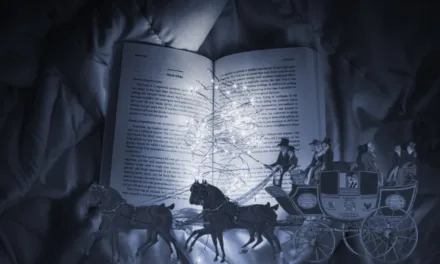
How do you know if your story idea is big enough for a novel?

“Hiya. How do you know if an idea is big enough to span a whole novel? I often fall short when outlining because there’s just not enough depth to the idea.”
This is such a relatable question. When I’m brainstorming, I often go to either extreme. I have too many ideas that go beyond the scope of the project I want to write (not every project has the scope of a ten-book epic, no matter what my brain might try to tell me), or are just the seed of an idea that I don’t know how to develop yet.
But the great thing about the seed of an idea is that if you give it the space it needs to grow, it will almost always turn into something worthwhile. Story ideas don’t always start fully formed. In fact, it’s more usual for them to be nothing more than a character you came up with, or a single scene you want to write and build something around.
You’re definitely not alone in this struggle. Realistically, some ideas won’t develop further than the initial thought. But if you’re invested in the concept, then you can build your story, layer by layer, until you have something you can work with.
There are ways to evaluate your idea’s potential before you commit to writing. Let’s explore how to recognise if your idea has novel-worthy depth and what to do if it needs more development.
Understanding story’s potential
When you have an idea and want to decide if it’s worth developing into something novel-length, then you need to consider some of the critical elements that make a novel what it is.
To write a great novel, you’ll need:
- Multiple layers of conflict that can sustain a reader’s interest.
- Room for character growth and development.
- Room for meaningful subplots.
- Themes that you can explore in depth.
- Opportunities for complex relationships to develop between characters.
Take your idea and compare it to these metrics. Does anything stand out to you? Take a few moments to brainstorm.
What potential conflicts could come out of your idea? What role will your characters play? Is there a theme that fits your idea? If you manage to jot down some ideas based on these metrics that excite you, then your idea has development potential.
But if you brainstorm and can’t think of anything that excites you to write, then it might be best you move on to another project and leave this specific idea in the archive (who knows, you might find inspiration in it later!).
What you need to develop to build a novel
Once you’ve determined that you can develop your ideas into something more, you then need to actually start the development process. Most ideas start small, so it’s up to you to put in the work to make them bigger.
Here are some elements you’ll need to build out to turn your story from just an idea into something that can sustain a novel.
Complex conflict structure
Your central conflict should be substantial enough that it can’t be resolved quickly or easily. If you can solve your character’s problem in a few chapters, you might have a short story rather than a novel. To sustain a novel, you need to develop conflicts that:
- Have far-reaching consequences.
- Require multiple steps to resolve or could go wrong in the attempt.
- Impact various aspects of your character’s life.
- Create opportunities for character growth.
- Generate natural subplots.
Rich character development
Your protagonist should have enough room to grow and change throughout the story. What are their goals, motivations, and conflicts?
- What do your characters want?
- What stands in their way?
- What internal struggles will they face?
- How will their relationships evolve?
- What lessons do they need to learn?
- What false beliefs do they need to overcome?
World-building opportunities
Even if you’re writing contemporary fiction, you need to have a rich story world in which your novel will take place. Good world-building should:
- Influence how characters behave and make decisions.
- Create natural obstacles and complications based on the society your character moves in.
- Offer opportunities for meaningful subplots. This could be social, political, or even just through family dynamics.
- Provide context for character motivations. Characters, like people, are the product of their environments.
How to expand a thin idea
If your idea feels a bit lightweight, don’t worry. We’ve all been in the same boat. A novel doesn’t come into being fully formed. They all start as a single idea that gets developed into what the reader finally gets to experience. Here are some techniques to help you brainstorm and develop your ideas into something bigger.
Ask “what if” questions
Start with your core concept and keep asking “what if” questions to uncover new possibilities. Each answer can lead to new plot threads or character developments. For example:
- What if your character’s solution creates a bigger problem?
- What if achieving their goal costs them something important?
- What if their actions affect others in unexpected ways?
Explore ripple effects
If you’ve already brainstormed to find out if your idea has novel potential, you should have at least a vague idea of what the story’s conflict might be. Take the conflict and explore how it could affect:
- Your protagonist’s relationships.
- Other characters’ lives and goals.
- The wider community or world.
- Future events beyond the immediate story.
Don’t like any of those? Consider if there’s another conflict possibility that could go with your initial idea and repeat the exercise.
Develop subplots
Your story idea is probably going to be the basis for the main plot, but there’s more to a novel than just a single storyline. You need to develop subplots to really bring a novel to life. Brainstorm some subplots that:
- Complement or complicate the main plot.
- Explore different aspects of your themes.
- Develop secondary characters.
- Add depth to your story world.
What to do if you can’t develop your idea
Not every idea you have will make it into a finished state. My Novlr account is filled with projects I’ve created that contain a single random idea I had that never saw the light of day. That’s part of the process and nothing to be ashamed or afraid of.
Ultimately, you need to be honest with yourself about your idea’s potential while remaining open to possibilities for expansion. Sometimes, what starts as a simple concept can grow into something much bigger once you give yourself permission to explore it fully, but it will take work to do so. So, you’ll need to determine for yourself whether this idea is the one you want to dedicate that work to.
Trust your instincts. If an idea keeps presenting new questions and possibilities as you develop it, that’s a good sign you’ve got something that can sustain a novel-length work and that you’ll be excited to write. And if not? Well, there’s always the next idea waiting to be explored.
































